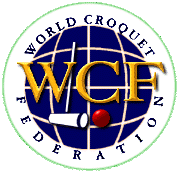As posted on www.croquetworld.com
When Mark McInerny of Ireland won the 2011 Golf
Croquet World Championship by beating
Hisham Aboesbaa in 3 games (7/4-7/6-7/5) it was an
exciting end to what I consider an historic
championship. Mark, a wild card who played a very
simple and efficient game, is to be congratulated, as
well as Hisham, who had to fight his way into the
event from the qualifying tournament.
A non-Egyptian winning the Golf Croquet world champion
was going to happen sooner or later. Winning the Under
21 championship briefly gave the Egyptians a sense of
reassurance that the future would be as bright as the
past. That hope was crushed with Sunday's result, when
the Irishman Mark McInerny wrote an entirely new
chapter in the fascinating story of the evolution of
golf croquet on the world stage.
Although both players missed hoop shots and ball
clearing shots throughout the match, the difference
was that Mark missed the less critical ones. There is
no doubt that Mark's victories over the Nasr brother
(Mohamed and Ahmed) in the round of 16 and semifinal
respectively boosted Mark's confidence and may
have had the opposite effect on Hisham. Although the
final match lacked spectacular shots (with the
exception of Mark’s hoop 4 in game 2), for croquet
purists it was good match. And for those who have
waited for years to see the Egyptians dethroned, it
was an excellent match.
YOUTH WILL REIGN AS THE EGYPTIAN STYLE IS DETHRONED
The participation of youth and the dethroning of the
Egyptian style are two significant and interrelated
contributing factors in the historic equation. Golf
Croquet youth programs in Egypt, England and New
Zealand were well represented and showcased in this
tournament. This infusion of young blood gives our
sport a new and exciting potential. These young
players will compete against each other for many years
to come.
This tournament showed the largest youth gathering
ever for a GC world event. The combination of the
decision to qualify the top 2 from the Under 21 event
that preceded the tournament and having the
championship in England - a country with a strong
youth presence - allowed for this large youth
participation. It is my prediction that playing
Association Croquet will give the young players from
England, New Zealand and the rest of the world an
advantage over their Egyptian counterparts.
We are in the midst of a paradigm shift. In the past
people thought that you must hit hard to beat the
Egyptians. This hard-hitting style was effective
because it had a dramatic and intimidating effect on
the opponents; it was very strange to most non-
Egyptian players (NEP). As the NEPs became more
exposed to the Egyptian style and started beating
Egyptians in various events, the psychological barrier
was broken. The other change is that as time went by,
the NEPs improved their game at various levels. Some
added more power to their shots, making their clearing
shots more effective clearing. Others learned more
tactics from playing against and watching Egyptian
players. The Egyptian game, on the other hand,
stagnated.
In my analysis of the 2002 Golf Croquet world
championship final, I described the different levels
of tactics in Golf Croquet. I mentioned at the time
that the high level of tactical knowledge possessed by
Khaled Younis and Salah Hassan is absent in other
Egyptian players. Therefore Egyptian players who used
to enjoy the advantage of hitting hard are now
struggling when their opponents start to hit back but
not as hard. Now the tables are turned, and the NEP’s
disadvantage of the past is becoming an advantage.
When NPEs hit back, their balls are still in the
vicinity of the hoop, which puts the Egyptian player
in a conundrum, because placing the ball now requires
a more sophisticated level of tactics.
Also the prolonged play around the hoop puts the
Egyptian players in an uncomfortable position, as most
of them lack the patience to continue to play and make
multiple shots to gain control of a single hoop. This
was the secret of Hisham’s success in this tournament.
He gained an edge over the rest of the Egyptian field
because his shots were not as strong as the rest and
he hit so many balls in the center, remained within
the vicinity of the hoop. This allowed him to continue
to be effective when his opponent hit him back. This
was evident in his match against Bamford.
TO MAINTAIN A COMPETITIVE EDGE EGYPTIAN COURTS MUST BE IMPROVED
This is a generational issue. The existing class of
Egyptian players - the generation now playing - will
not learn to hit softly. They will continue playing
with their style and will win some and lose some.
Egypt will continue to produce amazing hitters. But it
is difficult to imagine how Egypt can begin to produce
shooters with soft and accurate shots without
improving the standard of the courts in the Egyptian
clubs.
I couldn’t help thinking about our youth program in
America. I truly hope to see more young American
players participating in Golf Croquet events. Our
problem is our geography, with huge distances
preventing the frequent peer-level competition among
the strongest players needed to advance levels of
excellence in the game. So we will continue to focus
on local activities and hopefully we can come up with
annual or semiannual events for everyone.



